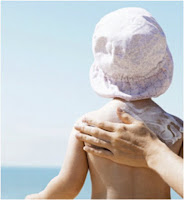
Here in Arizona, sun safety is a crucial part of our daily routine. But with summer comes more opportunities for you and your child to be in the sun, such as swimming lessons with Kidtastics, camping or boating trips, and cooling off with a refreshing dip in the pool. To ensure your child stays protected from the sun’s rays while enjoying the season’s many outdoor activities, here are some helpful tips:
Babies younger than 1. A new baby’s skin burns more easily, so try to avoid limit exposure (especially direct exposure) until he is 6 months old. Keep his skin covered, even in the shade. It’s OK to use sunscreen if you find yourself in a situation where you can’t keep him out of the sun. Apply the sunscreen to a small area of his back first to make sure there is no irritation, and then apply only to face and hands, and keep the rest of him covered up. When choosing a sunscreen, ensure that it is made for babies (they have less irritants) and have an SPF of at least 30.
Children age 1 year and older. Young children should stay out of the sun as much as possible, but of course that gets harder to accomplish as they get older and more active and independent. Apply sunscreen 30 minutes before she goes outside and reapply it every two hours—more often if she goes swimming or is sweating. Be careful not to get sunscreen on the eyelids! As with babies, use a waterproof, broad spectrum sunscreen made for children with a SPF of at least 30.
Spray-on Sunscreen: When it comes to sprays, there aren't any clear guidelines about how much to use; most simply recommended applying "evenly" and "generously" or "liberally." Some say to rub the sunscreen into the skin, while others don't; most also recommend using in well-ventilated areas. All warn to keep the product out of the eyes and not to spray directly on the face. Our recommendation is to read directions on the bottle carefully to ensure you are getting the maximum protection from it.
Don't rely on sunscreen alone. When outdoors, kids should wear a hat with a 3-inch brim or a bill facing forward and a long-sleeved shirt and long pants made from tightly-woven cotton provide smart protection against the sun. Sand and concrete reflect the sun’s rays, increasing the chances of a burn. Most rays make it through a cloud cover and they also travel through water, so an overcast day or staying in the pool doesn’t provide protection. Limit your sun time, and seek shade during the hottest hours of the day.
Other tips:
•Don't spray or rub sunscreen on clothes. Most of the products stained fabrics when applied directly and left for a day.
•Don't use sunscreen after its expiration date because it might have lost its potency. If your sunscreen has no expiration date on the bottle when you buy it, mark one yourself with a permanent marker and throw out after two years.
(Source: consumerreports.org)
No comments:
Post a Comment